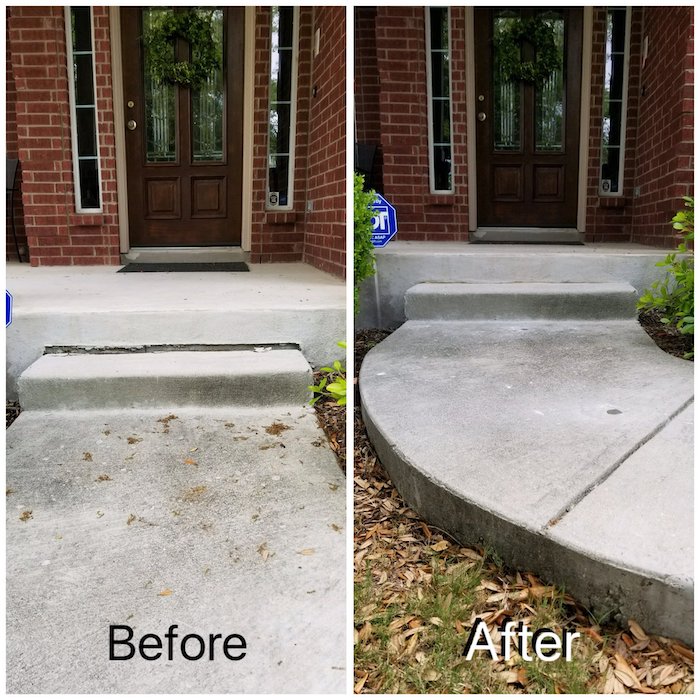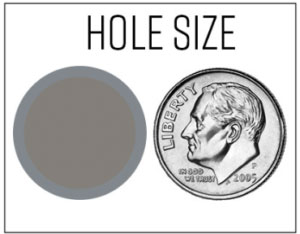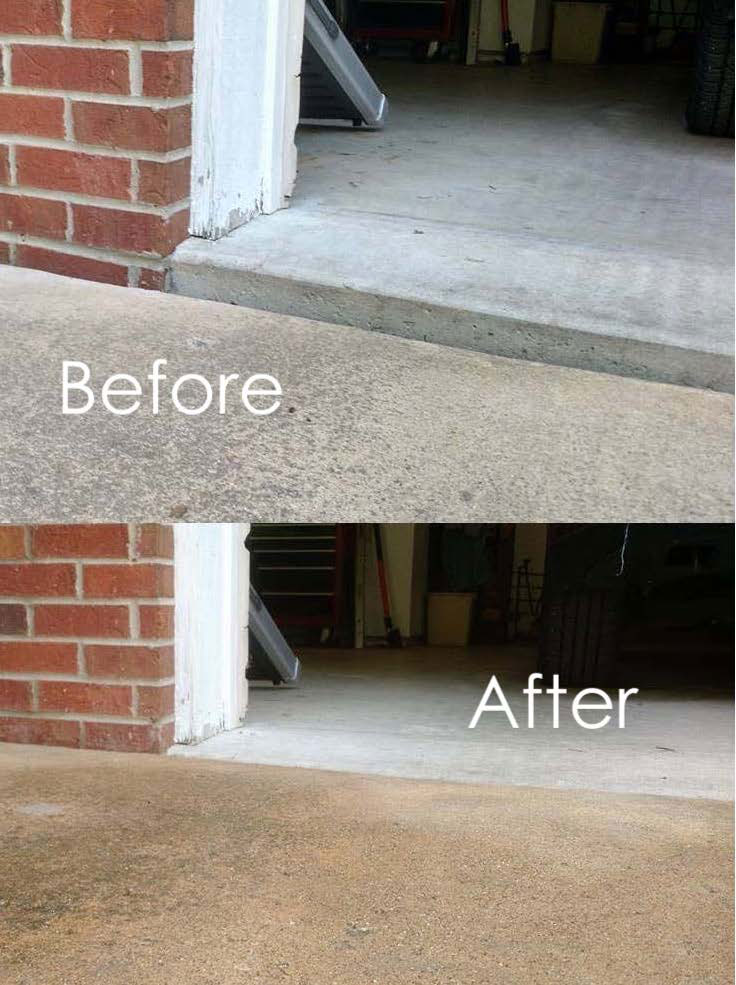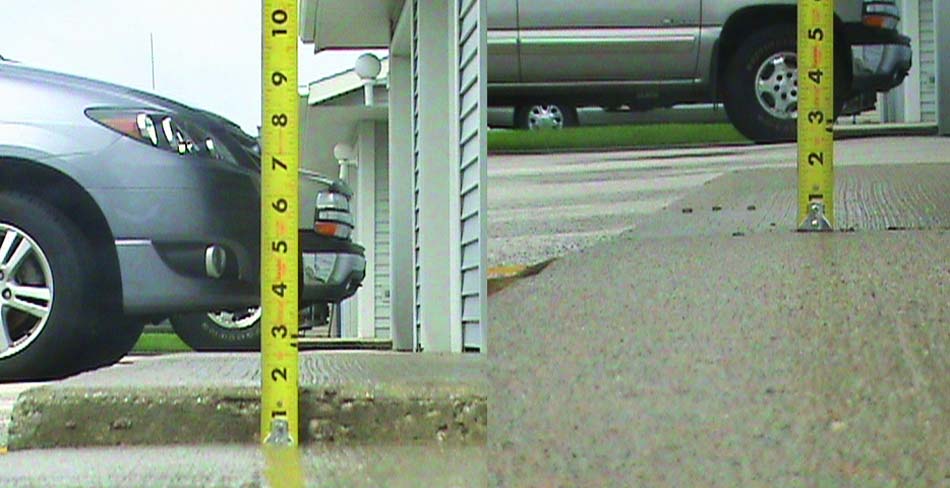CONCRETE LEVELING | Plainfield, IN
Need your concrete leveled in Indy? We can help! Call / text / email for a FREE Estimate.
Sinking driveway? As concrete leveling experts, we level Plainfield driveways on a regular basis. We can remove those gaps between your concrete slabs and bring your driveway flush to your garage floor again. Driveway Leveling
Restore your home’s curb appeal by leveling that crooked sidewalk! Leveling your sidewalk can correct your property’s grade and remove tripping hazards. Sidewalk leveling.
Have a commercial lot that needs concrete leveling? We can polyjack any concrete slabs that may have shifted with time and are causing you problems. From uneven parking lots to crooked steps, let us bring your business back up to snuff.
What is concrete leveling?
Concrete leveling is a process for leveling sinking or uneven concrete in which a polyurethane foam is injected beneath a concrete slab that has sunken in order to raise it back to its original position. For example, if you have a walkway where the slabs are no longer flush or have shifted positions, polyjacking will fix the slabs so that they are even and no longer a tripping hazard.
What type of concrete can be raised?
We offer concrete leveling services for any concrete slabs that are sinking, such as driveways, sidewalks, walkways, garage floors, porches, concrete steps, patios, pool decks and more! We provide concrete leveling for both residential and commercial properties throughout Indianapolis.
What is your service area?
We serve Indianapolis and Marion County, including Clermont, Rocky Ripple, Williams Creek, Beech Grove, Southport, Warren Park, Wynnedale, Spring Hill and more areas surrounding Indy, including Carmel, Fishers, Noblesville, Lawrence, Westfield, Zionsville, Beech Grove, Speedway, Greenfield, Anderson, Martinsville, Mooresville, Bargersville, Ellettsville, Camby, Cloverdale, Bloomington, Plainfield, Franklin and more.
How does concrete leveling work?
This video shows how the concrete leveling process works. In short, we drill small holes and inject expanding polyurethane foam beneath the slab until it is in the proper position.
 Why do I need my concrete to be level?
Why do I need my concrete to be level?
There are a number of reasons why level concrete is important. The grade around your home plays a huge part in ensuring your home does not flood and keeping your foundation in shape. Water needs to flow away from your home, and if your concrete walkways, steps, driveway, or porch are not properly graded, water can funnel toward your home instead. Leveling your concrete can fix this problem, prevent further sinking of your concrete and even damage to your concrete, which can lead to it needing to be replaced.
What services do you offer?
At Indianapolis Concrete Leveling & Mudjacking, we collaborate with you to identify problem areas around your home or business in Plainfield, IN, and determine the best solutions to fix them. Plainfield experiences its share of heavy rainfall and snow, which can lead to water damage and uneven concrete surfaces. Our team will ensure your concrete is properly leveled, preventing water damage to your property and foundation, and eliminating tripping hazards caused by uneven concrete slabs.
How much does concrete leveling cost?
Like most services, the cost is going to depend on the level of repairs needed. If you have a small section of sidewalk that is tilting vs several large areas of driveway that are sagging, the costs are going to be very different. However, you can expect that most concrete leveling services are going to cost a few thousand dollars. We can provide a free, no obligation quote so you know what to expect.
What caused my concrete to sink?
The most likely culprit is water. Whether it is rain water, a leaky pipe, or a misplaced downspout, water can get beneath your concrete slab and wash away the soil. Other reasons can be poorly compacted soil, shifting earth, or even rodents. Anything that can cause a void, or an empty space, beneath the slab can cause it to begin sinking and shifting. By filling this void and leveling the concrete, you can raise it back to its regular height and prevent it from happening again.
Why do I need to fix my uneven concrete?
Uneven concrete in Plainfield can lead to numerous issues, including water drainage problems that direct water toward or into your home or business. This can result in foundation damage, flooding, mold, mildew, and rot. Additionally, uneven slabs pose a tripping hazard and can diminish the curb appeal of your property. If not addressed, these slabs may continue to sink or lose support, eventually leading to cracking and crumbling, which necessitates complete replacement. By hiring professionals from Indianapolis Concrete Leveling & Mudjacking, you can rectify the uneven concrete before it causes major problems and prevent future occurrences.
Why shouldn’t I just replace my concrete?
The first reason… Cost. Replacing concrete costs much more than leveling the existing slab. Because of the labor involved in tearing up and disposing of old concrete, regrading the subsoil, then pouring new concrete, the process is long and costly. Plus with our slabjacking process your existing concrete slab(s) only takes a few hours, are ready to be used almost immediately, and will not disrupt you or the neighborhood with heavy equipment. So no mess, use your concrete immediately, less waste, and you save a bunch of money 🙂
Do I need to be home during the process?
Unless the concrete slab you want polyjacked is inside your property such as a garage floor, you don’t even need to be home! With your permission we can level your concrete any time, saving you the hassle of having to schedule your day around the repair.
There can be a lot of questions regarding the process of concrete leveling. Polyjacking, also known as slabjacking, concrete leveling, and concrete lifting is the process by which a concrete slab is lifted back into place by injecting a polyurethane expanding foam beneath the slab. Here are some of the common questions regarding the polyjacking process.
Does polyjacking really work?
Yes,it works! Polyjacking is a quick and easy process that leaves behind minimal traces it was ever done, other than your concrete being back the way it should! Polyjacking is a more modern approach to concrete lifting than mudjacking, and creates fewer indications that it was even done. However, if your concrete is heavily deteriorated or cannot stand up to the process of being lifted, then it may not be the best solution for your problem.
How long does polyjacking last?
Polyjacking uses a polyurethane foam that is waterproof and will not degrade. Because of this, the foam itself is permanent! However, you may still have shifting concrete if the source of the soil displacement is not also corrected. If the cause of the soil shift or washout is corrected, polyjacking can be a permanent solution.
 Polyjacking vs Mudjacking
Polyjacking vs Mudjacking
Polyjacking uses a quickly expanding polyurethane foam to lift the concrete. The overall process is similar in that holes are drilled in the concrete, however the holes for polyjacking are smaller than those used for mudjacking, leaving behind less evidence the work was done in the first place. The polyurethane foam in lighter in weight and waterproof, while the “mud” used for mudjacking is both heavy and can degrade over time due to water. The polyurethane foam can completely fill a void beneath a slab and will not compress the soil beneath. The slurry used for mudjacking is comprised of rougher natural materials and therefore may not be able to reach all of the areas in a void, leading to a greater possibility of future sinking. While polyjacking can be more expensive than mudjacking, the likelihood of having to mudjack again is much higher, meaning you may have to spend the same amount again several years down the road.
Polyjacking vs Concrete Replacement
Polyjacking is a less expensive and less intrusive process than concrete replacement. If your concrete slab is in structurally sound condition, polyjacking will be able to correct the problem in a matter of a few hours. Concrete replacement is a much longer process. First, the existing concrete must be broken up and hauled away. Next, the subsurface needs to be prepped and new concrete poured. The concrete needs to cure before it can be used, which can take days. This time consuming process is also not a guarantee that the new concrete won’t sink in the future! When fresh concrete is poured, the color of the concrete will be lighter than existing concrete around it and will stand out. Also, if you have decorative concrete such as stamped or colored concrete, the next concrete will likely not match precisely. Polyjacking is minimally invasive and will not cause any disruption to surrounding landscaping, and requires little to no cleanup afterward. Unless your concrete is cracked to the point where it can no longer be safely lifted, polyjacking offers a much more economical solution.
What is your concrete leveling service area?
 Indianapolis Concrete Leveling & Mudjacking provides polyjacking to customers in Indiana, including Plainfield, Carmel, Fishers, Indianapolis, Westfield, Zionsville, Whitestown, Northfield, Noblesville, Meridian Hills, Castleton, Eaglewood Estate, Lawrence, Kokomo, Munice, Marion, Layfette, Fort Wayne, and more.
Indianapolis Concrete Leveling & Mudjacking provides polyjacking to customers in Indiana, including Plainfield, Carmel, Fishers, Indianapolis, Westfield, Zionsville, Whitestown, Northfield, Noblesville, Meridian Hills, Castleton, Eaglewood Estate, Lawrence, Kokomo, Munice, Marion, Layfette, Fort Wayne, and more.
Is there much cleanup necessary after concrete leveling?
There is very little cleanup, if any, needed after your concrete has been polyjacked. There may be small amounts of cement dust from the drilling of the holes in the slab, but that can be easily rinsed away with a garden hose. Because our equipment is small, we do not disturb your lawn or garden beds, and you’ll never even know we were there except your perfectly leveled concrete.
What maintenance is needed after concrete leveling?
There is only minor maintenance that will be needed after polyjacking your concrete, and it’s simple. The likely culprit for the sinking in the first place is that water got beneath your slab. The easiest way from preventing this from continuing the happen is to seal any gaps or cracks in the concrete. Cement caulk can be purchased from your local hardware store, and this will help keep out water in the future.
What will I notice after the concrete lifting?
We hope you’ll notice that your concrete is now straight and level! However, there may be other small differences you notice. When the concrete is lifted, small hairline fractures that were already there may become noticeable, and need to be filled with cement caulk. The small drill holes that are used to lift the slab will be barely discernible. Because you are keeping the same cement slab, the color will remain the same, unlike replacing concrete. What you’ll notice is that you’re not tripping over those pesky uneven slabs or seeing a gap between your steps and your home.
How long does polyjacking last?
The polyurethane foam that is used in the concrete lifting is solid material that is impervious to erosion caused by water, insects or rodents. The foam itself will last indefinitely, however there is always the possibility that your subsoil will continue to shift beneath, causing future sinking. By maintaining your concrete by filling cracks and gaps, the process will last longer.
Do I need to be home during the polyjacking process?
Most likely, no! The only time you would need to be home is if the slab that is being leveled is inside, such as a garage floor. Otherwise we can do the work whether you are home or not! This leaves you to go about your normal routine without having to worry about taking time off of work or putting off running errands.
Why should I worry about uneven concrete?
Uneven concrete can lead to many more problems than you probably realize. On top of being unsightly with crooked sidewalks or leaning steps, there can be problems lurking beneath. Kansas City gets a lot of rain per year, even by Midwestern standards. When your concrete is not properly graded away from your home or business, it can lead to water related issues. Flooding, pooling water, mold and even foundation issues can be costly to repair. If you have a walkway or driveway that is funneling water toward your home instead of away from it, it’s only a matter of time until you experience one or more of these problems.
Trips and falls are no joke, especially when they happen at a place of business. When you have uneven walkways or steps that are not longer level, these can lead to serious injury. Indianapolis Concrete Leveling & Mudjacking makes sure your concrete is level so you can avoid these hazards.
If your concrete is sinking, chances are it will continue sinking until the integrity of the slab itself is compromised. Without leveling your sinking concrete in a timely manner, you may run out of time for it to be an option, and have to resort to costly concrete replacement. Save yourself the money and hassle of having to replace your concrete altogether by getting it polyjacked at the first sign of sinking trouble.
What is causing my concrete to sink?
There are a few reasons that your concrete can be sinking, but most of the time it is because of water. Soil erosion beneath the slab is the reason your concrete is sinking, and it could be because of rain water, runoff from a roof or a misplaced downspout, or even a pipe leaking beneath the slab itself. When water gets beneath the concrete, it will begin to wash away the soil, creating a void, or empty space. Because of the weight of the concrete, it will begin to settle and shift when these voids are present. Concrete Leveling finds these voids and fills them, leaving you with level concrete once again!
 Why shouldn’t I just replace my concrete?
Why shouldn’t I just replace my concrete?
Two things come to mind when we think concrete replacement: time and money. Concrete replacement is an expensive and time consuming process, taking days instead of hours. When you replace concrete, you’re paying for the labor of breaking up and removing the old concrete, disposal of the concrete, the expense of the new concrete, and potentially the cost of having to repair or replace landscaping damaged in the process.
When new concrete is poured, it can take days to cure, meaning you cannot use it. However, with polyjacking, the newly leveled surface can be walked on immediately, and a car can be driven on it in 30 minutes! The mudjacking process takes hours, while new concrete will take days. Even with new concrete, there is no guarantee that it won’t sink over time as well. So long as your concrete isn’t damaged to the point that it cannot be polyjacked, slabjacking is a much more time and cost effective way to go.
How much does concrete leveling and polyjacking cost?
The amount that the slabjacking is going to cost is completely dependent on the area that needs to be lifted and the size of the void(s) beneath the slab(s). When the size and scope is determined, Concrete Leveling Indianapolis can give you a free, no obligation quote. However, most polyjacking repairs will cost a couple thousand dollars.
How do I know if I need slabjacking?
There are several signs that you have concrete that needs to be leveled, however the most obvious is that you can see a difference in height between slabs. If you have slabs that are next to one another that are no longer level, it means one or more of your slabs are shifting. Be sure to look at your driveway, sidewalks, patios, etc. from all sides to see if there is a height difference appearing.
If water is no longer running away from your home, then this is a good indication that your concrete has shifted and needs to be polyjacked. While you may not be able to visibly notice these changes, you may see that water is pooling in areas it didn’t before.
Do you notice a hollow sound while bouncing a ball on a large concrete slab? Then you’ve got a void! Even if your concrete hasn’t started settling yet, you may notice hairline fractures starting to appear as the weight of the concrete is no longer being supported.
What doesn’t Indianapolis Concrete Leveling & Mudjacking do?
We do NOT offer concrete resurfacing, stamping, sealing, asphalt work, or other services like those. Instead, we lift existing concrete slabs that are not beyond repair so you save money rather than replacing concrete.
Avon, Anderson, Bargersville, Bedford, Beech Grove, Bloomfield, Bloomington, Brooklyn, Brownsburg, Carmel, Camby, Clayton, Clear Creek, Cloverdale, Cumberland, Edinburgh, Ellettsville, Elwren, Fishers, Fortville, Franklin, Gosport, Greenwood, Greenfield, Harrodsburg, Heltonville, Indianapolis, Lawrence, Martinsville, McCordsville, Monrovia, Morgantown, Mooresville, Nashville, New Whiteland, Noblesville, Paragon, Pittsboro, Plainfield, Smithville, Solsberry, Southport, Speedway, Spencer, Stinesville, Stanford, Trafalgar, Unionville, Westfield, Whiteland, Whitestown, Woodville Hills, Zionsville.